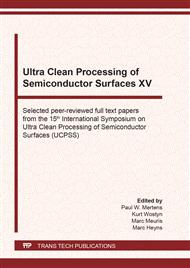[1]
L.-A. Ragnarsson, H. Dekkers, T. Schram, S.A. Chew, B. Parvais, M. Dehan, K. Devriendt, Z. Tao, F. Sebaai, et al., VLSI Tech. Digest (2015) 148–149.
Google Scholar
[2]
V. Vega-Gonzalez, C.J. Wilson, D. Briggs, et al., IEDM Tech. Digest (2019) 454-457.
Google Scholar
[3]
S. S.-W. Wang, Semiconductor Eng. (2019), https://semiengineering.com/3d-nand-challenges-beyond-96-layer-memory-arrays/.
Google Scholar
[4]
M.T. Spuller and D.W. Hess, J. Electrochem. Soc. 150 (2003) G476-G480.
Google Scholar
[5]
J. Haneveld, N.R. Tas, N. Brunets, H.V. Jansen, and M. Elwenspoek, J. Appl. Phys. 104 (2008) 014309.
DOI: 10.1063/1.2952053
Google Scholar
[6]
V.N. Phan, N.-T. Nguyen, C. Yang, P. Joseph, L. Djeghlaf, D. Bourrier, and A.-M. Gue, Langmuir 26 (2010) 13251-13255.
DOI: 10.1021/la1010902
Google Scholar
[7]
C. Virgilio, L. Broussous, P. Garnier, J. Carlier, P. Campistron, V. Thomy, M. Toubal, P. Besson, L. Gabette, and B. Nongaillard, Solid State Phenom. 255 (2016) 129-135.
DOI: 10.4028/www.scientific.net/ssp.255.129
Google Scholar
[8]
N. Vrancken; J. Li, S. Sergeant; G. Vereecke; G. Doumen; F. Holsteyns; H. Terryn; S. De Gendt and X. Xu, Langmuir 33 (2016) 3601-3609.
DOI: 10.1021/acs.langmuir.6b04471
Google Scholar
[9]
G. Vereecke, H. De Coster, S. Van Alphen, P. Carolan, H. Bender, K. Willems, L.-Å. Ragnarsson, P. Van Dorpe, N. Horiguchi, and F. Holsteyns, Microelec. Eng. 200 (2018) 56–61.
DOI: 10.1016/j.mee.2018.09.004
Google Scholar
[10]
G. Vereecke, XiuMei Xu, W.K. Tsai, Hui Yang, S. Armini, T. Delande, G. Doumen, F. Kentie, Xiaoping Shi, I. Simms, K. Nafus, F. Holsteyns, H. Struyf, and S. De Gendt, ECS J. Solid State Sci. Technol. 3 (2014) N3095-N3100.
DOI: 10.1149/2.013401jss
Google Scholar
[11]
G. Vereecke, H. Debruyn, Q. De Keyzer, R. Vos, A. Dutta and F. Holsteyns, Solid State Phenomena 282 (2018), 182-189.
DOI: 10.4028/www.scientific.net/ssp.282.182
Google Scholar
[12]
I. Marcus, Chem. Rev. 109 (2009) 1346-1370.
Google Scholar
[13]
G. Vereecke, World Chemistry Forum 2019, Forum 2-1: Nanochemistry, Barcelona, Spain, May 22-24, (2019).
Google Scholar
[14]
S. Ljunggren and J.C. Eriksson, Colloids Surf. A 129-130 (1997) 151-155.
Google Scholar
[15]
S.L. Warring, D.A. Beattie, and A.J. McQuillan, Langmuir 32 (2016) 1568-1576.
Google Scholar
[16]
K. Mawatari, Y. Kazoe, H. Shimizu, Y. Pihosh, and T. Kitamori, Anal. Chem. 86 (2014) 4068-4077.
DOI: 10.1021/ac4026303
Google Scholar
[17]
K. Morikawa, Y. Kazoe, K. Mawatari, T. Tsukahara, and T. Kitamori, Anal. Chem. 87 (2015) 1475-1479.
DOI: 10.1021/ac504141j
Google Scholar


